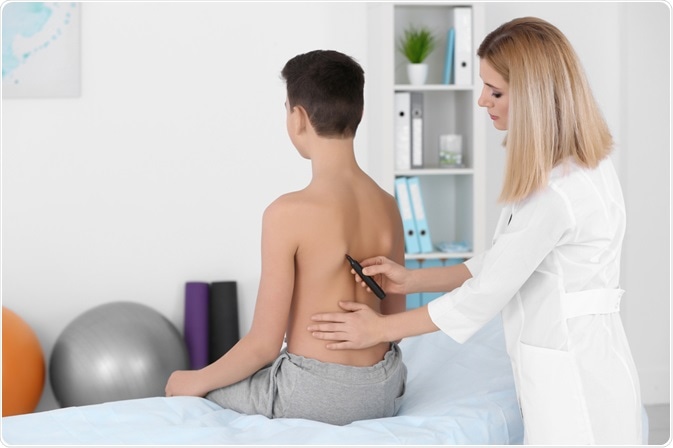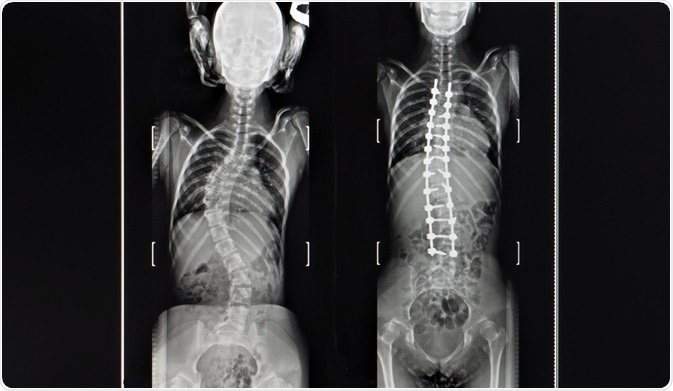The treatment of scoliosis depends on the type and severity of the spinal curve, the age of the patient, and the likelihood that the condition will worsen in the future.

Image Credit: Africa Studio / Shutterstock.com
There are several main courses of action that may be taken, which include watchful waiting or observation, bracing, and surgery.
Observation
Particularly for young children with scoliosis, treatment may not be needed, as the condition may self-correct as the child grows. For this reason, observation is required to monitor the progression of the spinal curvature throughout growth and to intervene if the condition shows signs of worsening. X-ray images are often used as a method to monitor changes in the curve of the spine.
Bracing
A back brace can be utilized for children with scoliosis while they are growing to prevent the spinal curvature from getting worse. This is not believed to help in the correction of the curve, however, and not all scoliosis specialists endorse the practice.
Ch.3 - What is Scoliosis Bracing?
The back brace should be fitted to the spine correctly, which is usually done by taking a cast of the child's back and tailoring the brace to fit this correctly. Braces may be rigid or flexible, depending on the materials used in their construction. Back braces for scoliosis are usually designed to camouflage well under clothing so that they are not a social hindrance for individuals.
Patients should wear the brace at all times, except for when bathing, showering, or during contact sports. For most other sports and other everyday activities, the brace can be worn as usual. The brace is usually needed until the child stops growing, at approximately 16 or 17 years of age.
For young children of less than two years of age, it may be possible to use a cast to guide the spinal growth and correct the curve associated with scoliosis. This is a type of external brace that is designed to be worn constantly and is regularly remodeled to foster new growth every two to three months. This method can be sufficient to straighten out the spine for some children, whereas others will need ongoing support with a brace as they get older.
Other therapies
Back pain is one of the most problematic symptoms of scoliosis, particularly in adults who suffer from the condition. For this reason, analgesic medications may be recommended to help manage the associated pain.
Paracetamol or nonsteroidal anti-inflammatory drugs (NSAIDs) such as ibuprofen or aspirin are usually the first-line medication choices. For more severe pain, corticosteroid or local anesthetic injections to the affected site may be beneficial but are associated with more side effects when used on a long-term basis.
Regular exercise is essential for people with scoliosis and should also be encouraged for children who need to wear a brace. Exercise is thought to improve muscle tone and body strength, as well as improve general posture and flexibility, although this has not yet been supported by scientific research.
There have also been some cases that demonstrate a benefit from alternative therapies, such as chiropractic treatment and electrical stimulation. It is not clear if these are effective beyond the placebo effect, but are sometimes recommended by practitioners.
Surgery
Corrective surgery may be an option for individuals who continue to have problems after trialing other treatment methods.
For children less than ten years old, growing rods can be inserted to help control the growth of the spine and may partially correct any existing damage. The rods will need to be monitored regularly and usually require lengthening two to three times per year as the child grows. These rods can later be removed when the adult height has been reached.

For teenagers or young adults, a spinal fusion may be needed in the treatment of scoliosis. This involves the straightening of the spine using metal rods and bone grafts to secure the spine in the correct positioning. This is considered to be a major operation and the rods typically remain in the patient's spine permanently as long as no problems arise.
There are several risks associated with a spinal fusion operation, including:
- Bleeding
- Infection
- Failure of the implant to fuse correctly
- Nerve damage to the spine (rare)
It is important for patients and their families to make an informed decision about spinal fusion surgery, considering both the benefits and risks of the surgery.
References
Further Reading
Last Updated: Mar 9, 2023